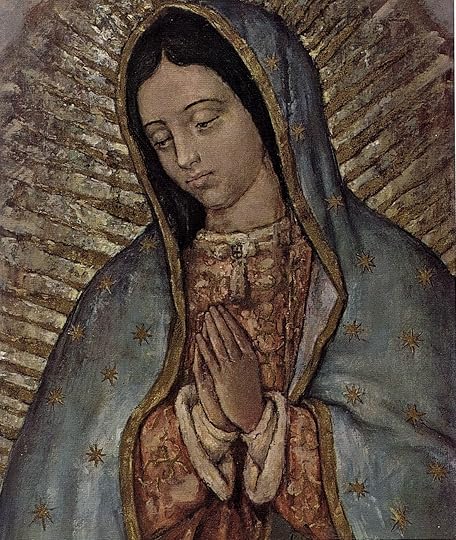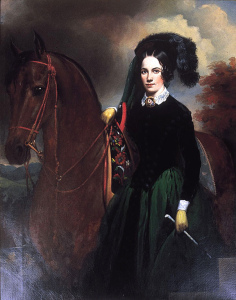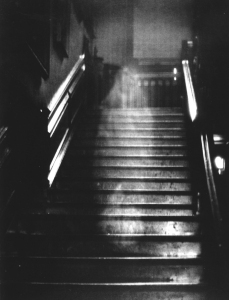Christopher K. Coleman's Blog, page 7
April 26, 2013
Tom Brown’s Ghoul Daze: Rugby, Tennessee
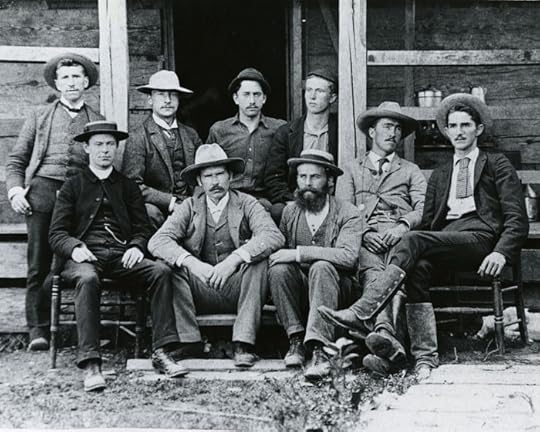
Early settlers of Rugby. The indolent sons of English nobility largely found Hushes’ work ethic uncongenial and soon left Rugby; the middle class Englishmen who settled there did not and stayed.
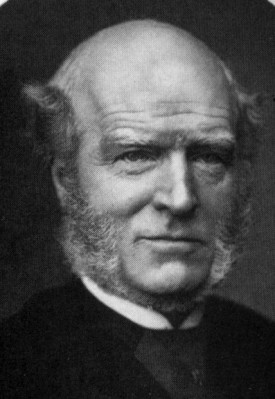
Thomas Hughes, author of Tom Brown’s School Days and high minded founder of Rugby, Tennessee.
First off, let me reassure folks: there are no ghouls in Rugby, Tennessee; no flesh-eating beings of any sort, at least that I know of, reside there. However, there is a gaggle of ghosts that inhabit the place, more per square mile than any town I know of. That is why this quaint rural village has been called “The Most Haunted Town in America.” It may, in fact, be the most haunted town in the world, although proving either assertion would be difficult, since the census bureau does not keep record of such things.
Rugby, Tennessee, is located high in the Cumberland Mountains, a wild and scenic area that while by no means backward, has not been subject to the massive influx of commercialism and corporate tourist development that the equally scenic Smoky Mountains have. The Cumberlands are located between Nashville and Knoxville, so to go from one to the ‘tuther, one passes through this area; travelers rarely stay there for their vacation, however, and mostly just pause in the region long enough for a lunch or brunch at one of the many restaurants and rest stops just off the interstate. A pity, since they miss quite a lot.
To give an idea of the difference between the two mountain regions of Tennessee, in the summer when one goes fishing in a beautiful mountain stream in the Smokies, one is generally doing so with dozens of other fishermen, all elbow to elbow enjoying the same stream. When you go fly fishing in the Cumberlands, you can cast your reel without worrying about snagging another anglers fishing hat in the process and the only anglers within sight of you also fishing is the occasional bear.
So while Rugby is not hard to get to, being about an hour or so from downtown Nashville, it is not a heavily traveled spot, which suits the ghosts just fine. In this brief review of the spirits of Rugby, we can but hit the highlights; I have covered the subject in greater depth in Chapter 2 of Strange Tales of the Dark and Bloody Ground.
Briefly, Rugby was founded by Thomas Hughes, the novelist famous for Tom Brown’s School Days. Hughes was a high minded sort and founded the town to provide a haven and gainful employment for the younger sons of titled English nobility who, because their elder brothers inherited the family wealth and titles, were dependent on handouts from the family patriarch yet were prohibited by social custom from gainful employment. So these younger sons whiled away their days drinking, gambling and whoring.
Hughes thought to provide in America a place where they could learn a trade and be productive members of society, so he funded the construction of this little Victorian English village in the Southern highlands. Unfortunately, while the village of Rugby served Hughes’ purpose, it turned out the younger sons of English nobility preferred to drink, gamble and go wenching instead of soiling their soft hands with any sort of gainful employment. What the late nineteenth century social experiment left behind was this village of quaint and beautiful Victorian homes and a number of mostly English ghosts in the heart of Dixie.
The first Tabard Inn, which burned under mysterious circumstances on Halloween, 1884.
One of the most famous haunts was the Tabard Inn, where a grisly murder took place in Room 13. Alas, one can not stay here, as the building went up in flames some years back. But I talked with the director once, who had interviewed eyewitnesses who testified that as the building burned they could hear screams coming from the vacant Room 13. Some think it was the ghost that haunted the hotel who set the fire.

The second Tabard Inn, scene of a grisly murder, burned under even more eerie circumstances and was not rebuilt.
Much of the Victorian furniture from the second hotel was salvaged from the fire however, and repurposed to homes throughout the town; some say cursed furniture was the cause of the supernatural phenomena spreading throughout the rest of the town. Others in Rugby disagree on this; but if you visit the town you may inquire further on that score.
More fortunate in its fate was Newbury House. Its owner was an English gentleman of high esteem but low birth who found the town quite congenial and sent for his family from England. He died before they came and now his ghost resides in Newbury House, still waiting for them to arrive.
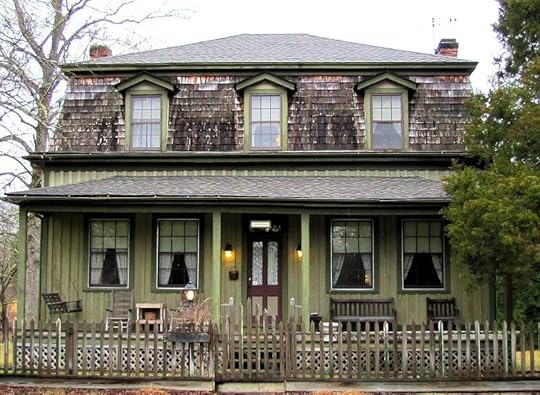
The Newbury House in Rugby, home to its own resident ghost.
Then there is the old Victorian library, which looks for all the world like something out of Harry Potter. Some call it the “Rip Van Winckle” library, because it seems as though when one enters it, one has entered a sort of time warp. Although there is a phantom librarian reported present there, its presence is mostly unseen. You, however, may have a different experience when you visit.
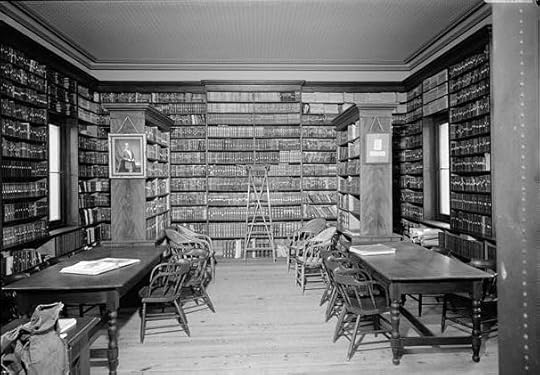
The old Victorian Library is thought to be presided over by the unseen ghost of a former librarian. Its presence is more felt than seen. Ssssh!
There are a number of homes in the town with ghosts, some more active than others and over the years eyewitnesses have reported encounters with them all. There is Kingston Lisle, Thomas Hughes’ sometime residence; there is Roslyn, a two story mansion with several spirits, including the wild carriage driver who thunders up to the front door in a black carriage. Then there is Twin Oaks, once home to a witch—and perhaps still is.
Again, for more in depth accounts of Rugby’s many ghosts one is better off consulting the chapter in Strange Tales. Then after reading, you will be armed with enough knowledge to tackle Rugby for yourself. The living residents are friendly and helpful to visitors and the spectral residents are mostly harmless—even if the occasional encounter with them is a bit startling. By all means, if you visit Dixie in your travels, Rugby is worth the trip.
For more of Tennessee’s ghosts and haunts, witches and monsters and things that go bump in the night, see Strange Tales of the Dark and Bloody Ground and Ghosts and Haunts of Tennessee; the two combined are essential reading for any interested in paranormal Dixie and Southern spirits.


April 6, 2013
Beware the Curse of the White Mule
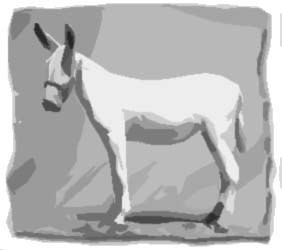
The Curse of the White Mule is one of Knoxville’s more persistent legends. Some say the curse has been lifted; others not.
Downtown Knoxville, like the heart of many Southern cities, has a long history–and quite of few ghosts. Although Ghosts and Haunts of Tennessee is mainly concerned ghosts and haunts, and a curse does not quite qualify as a haunting, it is in the realm of the paranormal nonetheless. In this case, the Curse of the White Mule was localized to a certain block of downtown Knoxville. It goes back to the mid-nineteenth century, when the Gypsy Circus once came to town. While the details of the story vary depending on who you listen to, the upshot was that the side-show’s prize display–a white mule–died unexpectedly while visiting Knoxville. The gypsies blamed the local folk for their the death of their valuable side-show freak; in revenge, they cursed the area and departed town in a huff.
Now people getting angry and cursing out certain people or places is not all that unusual; but when the curse comes true, it tends to get your attention. During the late nineteenth and early twentieth century, this area of downtown Knoxville had a series of uncanny fires break out, some quite severe. Since then, other weird disasters have happened which some say are also due to the Curse of the White Mule.
They say that libations will stave off the curse and in fact there is a tavern in the heart of downtown Knoxville where you may quaff a White Mule ale. Whether this will cure the curse I cannot say; but if you visit downtown Knoxville you may want to try. It couldn’t hurt.
For more details on the Curse of the White Mule, see Chapter 7 of Ghosts and Haunts of Tennessee. Good haunting!


March 15, 2013
Run Through the Bayou: Cajun Country Werewolves

The loup garou (or rou garou) is native to the swamps and bayous of Louisiana, although it migrated there from France.
In the section of Dixie Spirits dealing with Louisiana, there is a chapter devoted solely to the loup garou—the Cajun version of the werewolf.
Before researching that chapter, I had assumed, like most folks, that the werewolf’s home turf was mainly England and Germany. After all, thanks to Hollywood, who doesn’t know about the werewolves of London and their Anglo-Saxon and Germanic kith and kin? The truth is, like most else occult emanating from Hollywood and the media, they have got it all wrong.
While there are indeed credible tales of man-wolf encounters that come from the British Isles and Germany, the truth be told, the epicenter of lycanthropy—in the Old World at least—is France. While in English we have but two terms for the werewolf, in France and its former colonies there are no fewer than sixty different names for the werewolf and its kith and kin. One variant one hears in Louisiana, for example, is rou garou, who simply seems to be the Cajun version of the beast.
Of course we are all familiar with the French fairy tale of Beauty and the Beast and Perault’s Little Red Riding Hood likewise centers on a wolf who can walk and talk like a human, and devours human flesh—although Perault also intimated that the carnal desires of the werewolf had sexual overtones as well. But as early as the Middle Ages, the French were penning romances involving werewolves, including one by poetess Marie de France. Obviously, when the French first colonized Louisiana, something not quite human came with them to settle in the swamps and bayous of the Delta.
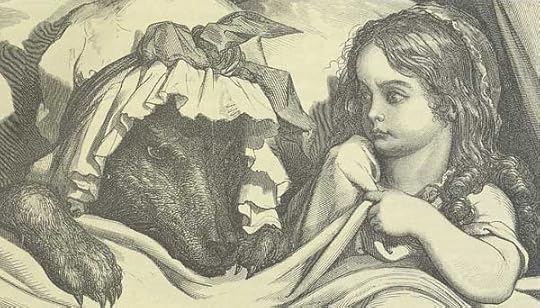
Charles Perault made the tale of an innocent girl falling for the wiles of a loup garou famous, but the story goes back into antiquity.
The French, in fact, make an important distinction between genuine werewolves—skin changers who transform from man to wolf—and those persons who are mentally deranged and imagine themselves to be wolves. The delusion they call lupomanie—lupomania—while the term lycanthropy is reserved for the phenomena of true werewolfism. Even in English, someone who is disoriented or out of their senses is called “loopy.” Sigmund Freud treated a case of lupomania in late nineteenth century Vienna, although he confused the issue by calling it lycanthropy.
Another popular misconception perpetrated by the media is that werewolves (assuming there be such things) are cursed with this condition through no fault of their own, that it is a curse brought on by a cruel twist of fate. In fact, from accounts in the Middle Ages we know that those who practiced lycanthropy did so willingly, using a belt of wolf’s skin treated with a magic ointment to transform themselves. They were, in fact, considered sorcerers and assumed to be in league with the devil.
[image error]
According to some lycans, they serve God not the Devil. In Italy they were called Benandanti and are “hounds of God” who fight witches and protect villages.
This last accusation—consorting with the devil—was disputed by at least one confessed werewolf. In 1692, in Livonia, on the Baltic Sea, one elderly lycanthrope named Theiss said that he and his confreres regularly fought the witches, who were in the service of the devil, and that he and his fellow lycans were in fact “god’s dogs.” In Italy there is a similar allegation; there the werewolves call themselves “benandanti” or “good walkers,” who, entering into a trance state, leave their human bodies and assume the spirit body of a wolf, in which form they do battle with the Evil Ones.
In the case of Louisiana’s loup garou, my sense is that though it is much talked about in general terms and Cajun folk will gladly spin a yarn or two for you, when you try to pin them down to specifics—date, place, name—they clam up real quick. Cajuns—or at least the ones I have met—are garrulous and outgoing, but when it comes to loup garou and who and where they may be found, my experience was an extreme reluctance to divulge specifics. Whether this is because they genuinely don’t know or whether they do and are afraid to talk I can’t say for sure, although I think the latter is true. I go into depth on this subject in Chapter 15 of Dixie Spirits and for more on it see that book.
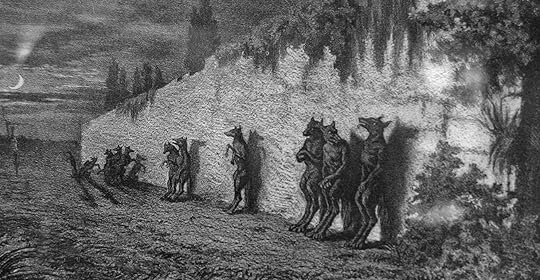
Werewolves, being gregarious folk–like the Cajuns–often gather together at the full moon to party and dance. Once place they have been alleged to hold their werewolves ball is Bayou Goula. The dance is not open to non lycans.
One curious fact I did uncover was that the loup garou of the bayou gather together and hold a ball or party on occasion and this fete du bete is alleged to occur near a small community in swamp country called Bayou Goula. Why there and exactly when the clans of werewolves gather to cavort and make merry remains a secret I have yet to plum. As with all else uncanny and unexplained, I often rely on the kindness of strangers to inform and enlighten me on such things. Therefore, any out there who know more than I have so far unearthed, I and other readers of this blog would love to hear from.
So while the loup garou may not be quite the evil monsters the media and the Inquisition have made them out to be, until we know more of this fey creature and his family, I would advise caution to the curious—especially when the moon is full.

Werewolves are traditionally believed to be ravenous beasts filled with carnal desire. Some confessed lycans have disputed this claim.
For more fey creatures and uncanny encounters in Louisiana and elsewhere in the South, see Dixie Spirits; for more weirdness in the same jugular vein, also read Strange Tales of the Dark and Bloody Ground.


March 13, 2013
Ulysses and Julia Grant: Paranormal Partners
February 11, 2013
Old Green Eyes: the Green Ghoul of Chickamauga

Ol’ Green Eyes, whatever it is, has roamed Chickamauga Battlefield since at least the time of the Civil War.
In my very first book of all things weird, wondrous and wicked in the Mid-South, Strange Tales of the Dark and Bloody Ground, in addition to the traditional haints, haunts and boogers, UFO’s and other unexplained phenomena, one curious tale revolved around the northern Georgia Civil War battlefield of Chickamauga. In that chapter I chronicled several of the battlefield apparitions known to haunt the battlefield, but the one which was the most curious, to my mind, was Ol’ Green Eyes, sometimes also known as the Green Ghoul. Since publishing that account, I have run into a few folks who have had their own tales to tell about this particular spook, so this venue I judge to be a good place to update my readers until I can prevail on my publishers to let me do a revised edition of that classic book.
Anyone who has visited Chickamauga knows it is a brief run from downtown Chattanooga—a brief run, that is, if you are a Yankee soldier trying to flee from ten thousand Rebels with bayonets all yelling like a banshee. Otherwise, it is about ten miles or more. At any rate, between the eighteenth and twentieth of September, 1863, thousands of Union and Confederate soldiers lost their lives fighting there, while thousands and thousands more suffered agonizing wounds.
It is not surprising, therefore, that quite a few ghost stories and reports of eerie encounters at Chickamauga have surfaced over the years. As I tell in my book, one version of Ol’ Green Eyes holds that he is a stone monument—dedicated to the Union brigade known Opdycke’s Tigers—that comes to life at night and stalks the countryside. I personally am dubious of that one—it has all the earmarks of a story invented around a campfire to scare gullible youths.

Opdycke’s Tigers, battlefield monument. Chickamauga; some claim this is Ol’ Green Eyes; others say it dates back to Indian days.
Another version holds that Green Eyes is a human looking ghoul, with top hat, gentleman’s cloak and long stringy hair; after the battle, it was said, this green eyed fellow went about munching on the bodies of the dead. It’s been a long time since that feast and he’s built up a powerful appetite since then. According to one source, this version was invented out of whole cloth by Park Ranger Ed Tinney some years back to entertain tourists.
While I can’t judge the veracity of the Tinney version, I do know that some park rangers go out of their way to deny any paranormal activity, in order to discourage people trespassing there at night. In all fairness, some self-appointed ghost hunters have vandalized historic sites in pursuit of nighttime thrills. The rangers at Chickamauga have been known to shut down all the secondary roads in the area at Halloween to keep out the thrill-seekers. So officials at Chickamauga National Battlefield have a rather strong motivation to deny accounts of Ol’ Green Eyes and other hauntings there, valid or not.
To my mind, the most credible accounts of Green Eyes are less specific; some have seen a green glowing light about Snodgrass Hill, while others describe a pair of eyes. Is it a ghoul, a ghost or a beast? Hard to say, but I have spoken to one man who had a close encounter.
Although Ed Tinney popularized Green Eyes, according to this local source, folks have known about the creature for generations; it’s just that in the old days you didn’t talk about such things, and certainly not to strangers.
After Strange Tales came out, I was doing a signing and this gentleman from Chattanooga, who bought a copy, told me of his experience.
It was some years back, when he was a hot blooded young teenager and since he had a few years on me, I am judging this was sometime back in the 1950’s. Well, he took a date out one Saturday night and after a little dinner and dancing they decided to park after dark; it was somewhere near Snodgrass Hill.
Then as now the park was closed to the public at night, but it was a favorite place for couples to go nonetheless. They were parked in his car with the top down, and he and his girlfriend were, shall we say, somewhat distracted at the time; that was until he felt the sensation of warm moist breath behind him. With a start he turned around to see two large green eyes glowing behind him.
The eyes were set apart, farther apart than any human pair of eyes could possibly be, and the creature was close enough to tell it was on the curved trunk of his car or close to it. Romance turned to terror in an instant; the teenager fumbled for the ignition, slammed his car into gear, and high-tailed it out of there as fast as his jalopy could go, just barely avoiding being Ol’ Green Eyes next meal.
There are those who scoff and those who deny, but for that mature gentleman at least, there is no denying that Ol’ Green Eyes is very, very, real—whatever it may be.
For more accounts of Civil War Ghosts and Haunts, read Strange Tales of the Dark and Bloody Ground; also see Ghosts and Haunts of the Civil War.


January 8, 2013
Roses in the Winter: The Twelfth Ghost of Christmas
Our Lady of Guadalupe, venerated as a miraculous image of the apparition that appeared to Juan Diego.
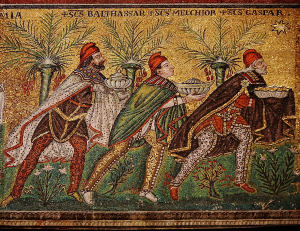
A late Roman portrayal of the three Magi (“Wise Men”) presenting their gifts; celebrated today as the Feast of the Epiphany.
The arrival of the Magi—“we three kings from oriental”—actually magicians or wizards, practitioners of the occult arts, who came to pay homage to the birth of Christ, is celebrated in most Christian circles as the Feast of the Epiphany. It is traditionally dated to January 6, and in Merrie Oulde Englande was called Little Christmas.According to former custom, this was the actual day when gifts were exchanged, much as the Magi gave Jesus gold, frankincense and myrrh. It was important because it was the first appearance of the Jewish Messiah to gentiles—the aforesaid non-Jewish sorcerers. Now anyone who wishes to celebrate the holiday properly and send me gold and incense for the Epiphany is more than welcome to: gold, well who doesn’t like gold; and as for incense, with four cats and a dog, believe me, I need that too. However, I’m not holding my breath on that score.
The Feast of the Epiphany is also the twelfth day of Christmas according to our reckoning and a fit day to conclude the Twelve Ghosts of Christmas. In Anglo-Saxon England, Yuletide actually continued on through to February, with much wassail and ample quantities of ale; nowadays most of us have to get back to work and save the wassailing for Super Bowl Sunday; the ailing follows closely upon the hangover the next day. But I digress a bit here; for now, let us consider one last Christmastide apparition and then we shall close the book (or bell, book and candle) and hope the spirits rest in peace till next Yuletide.
There are many different sorts of apparitions, as we have amply seen. Some appear almost daily, as if they were on a loop of ghostly videotape set on infinite play; others occur just at certain times, as with most Christmas ghosts; but some apparitions appear just once or twice to deliver a message, then never again. Our last apparition is of that latter sort and while little known of in northern climes, it is widely celebrated further south.
In fact, this apparition occurred so far south that it was where folk didn’t speak English, and at the time it occurred, not even much Spanish. The spirit I refer to is Nuestra Senora de la Guadalupe—the Virgin of Guadalupe. Today this particular spirit visitation is hailed as the patron saint of Mexico and indeed she is venerated as the patroness of the Americas as a whole. The odds are, if you have ever been to an authentic Mexican restaurant here in the Northwards, an icon of her has been lurking somewhere on the walls. That she is wildly popular among Mexicans and those among us of Mexican heritage, goes without saying. Those among us who are not of that cultural heritage may be unaware of the unusual story behind this intense devotion. Even if you are not a believer in saints or religious miracles, the story of her apparition—haunting, if you will—is a curious, yet true, one.
It actually occurred not long after the Conquistadors conquered—some say plundered and raped—the native kingdoms of what is now Mexico. The Aztecs were a proud and warlike people, and the truth be told, no better than the Spaniards who defeated them. Among the other tribes and kingdoms of Mexico, the defeat of the Aztecs was greeted as something of a relief—until they began to experience Spanish rule. In the wake of these European conquerors followed missionaries who came seeking neither gold nor glory, but rather came to bestow on the natives Christianity.
One of these converts to Christianity was a lowly campesino named Juan Diego. Born Cuauhtlatoatzin—Talking Eagle—Juan was a member of the Chichimeca tribe and spoke only Nuahatl—the language of the Aztecs and the other tribes of Central Mexico.
This day—the 9th of December, 1531—Juan was trudging from his little village into the city of Tlatelolco (now a neighborhood of Mexico City) to attend mass and take religious instruction. Juan was an eager convert to the new religion of the conquerors, it was true; but the complexities of this new religion were sometimes bewildering and so he and the other peasants like him were trying hard to understand the ins and outs of their new faith. The notion of one god, versus the many they had worshipped, for example, was peculiar enough in itself; that this one god could also be born of a virgin was even more confusing. Nonetheless, Juan trudged the dusty miles to the mission on foot to learn more about his new religion several times a week.
Only ten years before, Mexico City proper had been the pyramided imperial city of Tenochtitlan. It was the grand capitol of the great Aztec Empire, ruled over by a fierce warrior tribe who demanded human sacrifices from all the surrounding tribes. The human hostages given over to the Azteca elite by the surrounding natives were dragged to the tops of their high stepped temples and there they would have their hearts cut out still beating to feed the demanding and fearful Aztec gods; the remainder of their victim’s flesh was used to feed the Azteca warriors themselves. Now the temples had been razed and Spanish-style buildings and churches were being erected to replace them.
As Juan was climbing the hill the natives called Tepeyac, he heard singing on the hill, like the songs of many precious birds. Bewildered, Juan stopped and looked around, thinking perhaps he was dreaming. Then Juan looked towards the top of the hill, in the direction from which the music flowed.
The singing stopped and then he heard a voice calling to him, saying “Beloved Juan, dearest Diego.”
Juan went in the direction of the voice, and as he did so, he suddenly became happy and contented within. When he reached the top of the hill he saw before him a Maiden standing there who beckoned him closer.
She looked to be a native, with dark hair, dark eyes and copper skin like him. The Maiden was young and beautiful to behold; the apparition seemed only about fifteen or sixteen and she wore around her a mantle of blue-green, and though her form seemed human, Juan knew she was no ordinary mortal.
Her clothing was shining like the sun, as if it were sending out waves of light and the stones and the crag on which she stood seemed to be giving out rays of light as well. The Maiden’s radiance was like many brilliant precious stones, as in an exquisite bracelet; the earth all around her seemed to shine with the brilliance of a rainbow in the mist, while emanating from her head came bright rays of light, like the spines of an agave cactus. Juan stood there speechless, entranced by the incredible spectacle.
Then she spoke to the bedazzled campesino in his own Nahuatl tongue: “Know, be sure, my dearest-and-youngest son, that I am the Prefect Ever Virgin Holy Mary, mother of the one great God of Truth who gives us life, the inventor and creator of people, the owner and Lord of the Sky, the owner of the earth. I want very much that they build my sacred little house here.” She then instructed Juan to go to the Spanish archbishop in the city and tell her of her wish that he build a house for her on that very hill.
In due course, Juan, the Indian peasant, went to the great residence of the Prince of the Church, the Archbishop Fray Juan de Zumárraga, only recently arrived in this brave new world, and told him of the appearance of the Blessed Mother and her request.
Although the good bishop did not openly laugh at the native peasant’s bold request, he thought this simple farmer just some deluded Indian, and demanded proof of what he claimed. That, the good bishop thought, would end of the matter.
Returning to the hill of Tepeyac, Juan told the apparition of the Bishop’s request for proof and suggested to the Maiden that perhaps she should have someone of noble blood transmit her instructions to the Prince of the Church, the archbishop.
But with soothing words the Maiden reproved Juan, and again she bade him go to the bishop and tell him her will. This Juan did and was again rebuffed and told to provide proof.
Coming back to the same hill, again he told the Maiden of the bishop’s doubt and demand for proof, a sign that what he said was true. The Maiden told him to return on the morrow and that she would give him that sign.
Juan almost didn’t return, for that evening his Uncle became very very sick; so sick the uncle thought sure his end was near. At his uncle’s request, Juan headed to Tlatelolco to seek a priest to deliver last rites. However, although he tried to avoid the place where the apparition had appeared, on the way Juan again met the Maiden. Ashamed he had tried to avoid her, he explained to her about his dying uncle. Unfazed, she told him to fear not; his uncle was already cured. And on returning home, he found it was so.
Then, on the day of the Winter Solstice, Juan returned to the same place on the hill of Tepeyac, and again the Maiden appeared before him. She now instructed him to go to a certain place on the hill and pick the flowers there. Juan knew that at this time of year no flowers blossomed in the high plateau, in the land where he and his folk dwelt. Yet obedient to the lady’s wishes he went to the place she told him of. There, looking all about him he found a field of fragrant and beautiful flowers in all in full bloom.
Juan Diego picked the flowers, dazzling in their variety and beauty, gathering them up in the folds of his tilma, his homemade agave fiber poncho. He presented them to the Maiden, who gathered them up in her hands; she then put them back again into the tilma and folded it up and strictly enjoined Juan not to open his serape again until he came into the presence of the archbishop, the Spanish grandee.
Only with great difficulty was Juan able to obtain yet another audience with the archbishop. The great Prince of the Church’s servants were loathe to let this lowly Indian back in, thinking His Grace had been harassed by this crazy native more than enough. Still, Juan persisted and after waiting and waiting, he was finally was ushered into the bishop’s presence.
As instructed, Juan opened the tilma to show His Grace the fragrant flowers of the Maiden. On opening his poncho, out fell the flowers, all fragrant and beautiful, as if it were a sunny day in May and not the Winter Solstice. Yet these were not just any flowers but Castilian Roses, flowers which not only did not blossom in December, but which only grew in Spain and only in the province of Castile, from whence the Conqueror of Mexico, Hernan de Cortes himself had come. But even this was not the most remarkable thing the bishop witnessed; for on opening the folds of the tilma, the Archbishop Fray Juan de Zumárraga and his by now bewildered and curious servants saw the very image of the Maiden that had repeatedly appeared to Juan. It was a perfect image, glowing in vivid colors, yet not painted by the hand of man.
This time it was the bishop’s turn to bow, bow before the peasant Juan Diego and his tilma. For although the archbishop was a proud man and of high birth and came from a family of great wealth in Spain, he was at heart also a man of great piety and faith. In the knowledge that he was in the presence of something otherworldly and miraculous, the bishop begged the forgiveness of the Lady of the hill for his cynicism and doubt.
In due course the “little house”—a grand cathedral—was built where she directed. Word of the apparition grew and of the messages the Maiden gave to Juan, until all the natives of Mexico came to venerate the tilma with the image of the Lady and honor her as their protector and patron. And centuries later, when the day at last came for the native folk of Mexico to throw off the yoke of their conqueror, they bore the image of Our Lady of Guadalupe before them to victory. In all things the folk of Mexico hold fast to their faith in The Maiden as their protectress and still believe in the miracle of the roses.
Since then, the usual cynics have tried to disprove or deny the apparition, claiming the image is a fake and merely painted on; yet to this date no one has been able to succeed in proving it is anything but what Juan Diego claimed that Winter Solstice day in 1531.
However, in all the various investigations and close analyses of that icon on that agave fiber poncho which have been conducted over the years, some curious facts have emerged. For one thing, in the pupils of the eyes of Our Lady on the cloth can be seen very small, almost microscopic, images of people; they seem to be images of the bishop and his servants present when the tilma was unfolded by Juan Diego, as reflected in Our Lady’s eye.
Another curious fact, and one only recently discovered, is about the stars that decorate the blue-green gown of the Lady of Guadalupe.
It had always been assumed that the stars were just a random decoration on the gown, in honor of her epithet of “Queen of Heaven.” However, a close analysis of those stars reveals the fact that they are not haphazard, but organized as actual constellations of the sky. Nor is the arrangement of those constellations random either, but in fact they are in the exact pattern they would have been in the sky in 1531, on the day of the Winter Solstice, the day when the tilma was presented to Archbishop Zumárraga. The only difference is that the constellations are a mirror image of how we would see them from earth. Imagine if her gown were the mantle of heaven; we would be looking up at them from the inside; but an onlooker viewing the tilma is seeing her gown from the outside, from the direction of heaven—hence the reverse pattern of the stars.
Our Lady of Guadalupe is a beloved icon and the story behind it most unusual; to date, all attempts to discredit it have proved fruitless—not that the professional debunkers haven’t tried. If, as the cynics would have us believe, it is a man-made fabrication, it is of such skill, subtlety and complexity as to boggle the mind. No ordinary mortal, much less an untutored native peasant, could possibly have rendered it. Any attempt to debunk the apparition of Guadalupe must also explain who, how, and why it would have been made.
Not just the faithful, but objective modern paranormal researchers have studied this and similar female apparitions which have been identified with Mary, the mother of Christ. They refer to them collectively as “BVMs” (Blessed Virgin Marys) and have a somewhat different view than the religious faithful. While accepting their reality, and positing them as genuine supernatural phenomena, they have wondered if something else is not also going on with such apparitions beyond what orthodox Christians are willing to comfortably accept.
The celestial symbolism of the robe of Our Lady of Guadalupe, for one thing, seems to point to certain astrological connections. Going back to the Christmas narrative in the Bible and the Feast of the Epiphany, we may note that the Magi in some modern New Testament translations have also been rendered as “astrologers”—presumably a more palatable epithet than magician or sorcerer. Indeed, the appearance of the Nativity Star at the birth of Jesus also implies astrological connections. That Mary is frequently referred to as the “Morning Star” (Venus) in early Christian writings also points to occult celestial connections on the part of the Queen of Heaven. We may note in passing certain celestial alignments have also been pointed out with regard to her Feast of the Annunciation as well.
It is not our purpose here to argue any particular theology or spiritual belief—although Moslems also venerate Mary in addition to many Christians—but rather to simply point out, as Shakespeare so nobly said, “There are more things in heaven and earth…than are dreamt of in your philosophy.”
For anyone wishing to investigate further these celestial connections with Our Lady of Guadalupe and the BVM, one can see for example the Immaculate Immigrant blog and regarding the Feast of the Annunciation (suspiciously close to the Vernal Equinox) see the dsdocnnor wordpress blog about the Pleiades and the BVM.

A chart of the star map portrayed on the Maiden’s mantle, via a devotional blog.
For those who simply can’t get enough about the spooky, the supernatural or the just plain weird, I refer you to Strange Tales of the Dark and Bloody Ground, Ghosts and Haunts of the Civil War, Dixie Spirits, Ghosts and Haunts of Tennessee and the latest, which should be on shelves soon in better bookstores if not already, The Paranormal Presidency of Abraham Lincoln.


January 5, 2013
For Whom the Belle Toiled: The Twelve Ghosts of Christmas, Post 11
Adelicia Acklen, whose skill at manipulating men would have made Scarlet O’Hara seem like a schoolgirl.
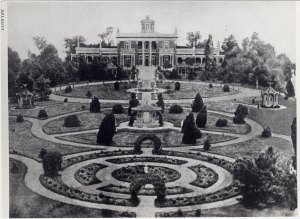
Belmont Mansion’s modest back yard, ca. 1863.
Many female devotees of the Late Unpleasantness are great admirers of the fictional heroine of Gone with the Wind, Scarlet O’Hara. Her wilfulness, her ability to manipulate men and her all around bitchiness have made her a role model for generations of GRITS (Girls Raised In The South). Outside of Middle Tennessee, however, there are few who know that there was a real life Southern belle whose actual antics put the fictional Scarlet to shame. Her name was Adelicia Acklen, the Mistress of Belmont Mansion.Not that Adelicia was at all bitchy. Oh no; butter would not melt in her mouth; she was a godly woman and prolific progenetrix. And she was very, very wealthy. Where once rows of magnolias blossomed, today stands Music Row; other vestiges of Adelicia’s estate have also gone with the wind (or kudzu as the case may be) but the mansion she once resided in, Belmont, remains and–at least at Christmastime–so does she.
Adelicia started off her career as a humble country girl in Sumner County, with several thousands of acres of prime farmland and a few dozen champion show horses to her name. Her father was a simple farmer whose wealth could only be counted by a handful of accountants working night and day. However, wealth begets more wealth, and the young and beautiful Adelicia married a prosperous doctor who amplified her estate and sired several children with her. Poor thing, his health was not so strong as her loins and he died prematurely, leaving her a wealthy widow. She remarried, this time to a far wealthier man, Joseph Acklen, who owned large plantations on the lower Mississippi, which produced bountiful crops of cotton.
In due course, Adelicia bore Joseph a bountiful crop of several more children and he in turn built her the magnificent Italianate mansion of Belmont. Sitting on a long sloping hill, one approached Belmont in the old days as if one were ascending Mount Olympus to visit the gods. Downton Abbey would have been a pauper’s hut compared to Belmont in its heyday. All went well, until the War.
Nearby Nashville fell early to the invading Yankee armies and the miles between there and Acklen cotton plantations in Louisiana were long indeed and for most of the war the area between the two a no man’s land in which the various armies marched and fought. Not long into the conflict, husband Joseph headed south to look after their financial interests along the Mississippi, lest their family fortune be ruined. Adelicia remained home to look after her growing brood of children and her thoroughbred horses.
Then one fateful day came word that her beloved Joseph had died of a fever tending to their cotton. Adelicia sobbed and sobbed and sobbed, saying “What am I to do, what am I to do!” and then it struck her: what about the cotton? Where the hell was it; had it been harvested; was it ready to be shipped—and how? Adelicia, for all her beauty, was not one to simply fan herself and stand idly by while her family fortune went up in flames. With no further ado, she piled a female cousin and two loyal servants in a carriage and headed into the hundreds of miles of lawless no-mans land, where deserters and robbers and guerillas would sooner kill you as look at you.
In the end she saved the cotton; shipped it abroad and sold it in England for premium prices, emerging even wealthier than before the war—a feat unique among Southern planters. For many years she was the queen of postwar Southern society and her evening parties and Christmas Balls were legendary. Belmont became the epicenter of postwar Dixie’s high society.
After she died, the reputation of Belmont as a grand place continued on. It became an aristocratic girl’s finishing school, Ward-Belmont, and finally a well respected academic institution, Belmont University. But over the years, various alumni and staff have had odd encounters within its august halls, things that cannot be explained by natural causes.
No one has actually seen Adelicia roaming the halls; but on more than one occasion, student, faculty and staff have had fey and uncanny experiences in the mansion, especially at Christmastime, that make them believe she is indeed still inhabiting the old manse.
One of the annual Christmas celebrations at Belmont is called “Hanging of the Green” and the students stage an elaborate ritual revolving around a tall winding staircase. Over the years, students involved in the Yuletide ritual have reported feeling a female presence there, while waiting for the ceremony to begin. Others hear the rustling of crinoline dresses, when no one is there. Other unexplained encounters also occur with uncanny frequency, especially around Christmas.
So, do Adelicia and other members of her ghostly clan still inhabit the august halls of Belmont Mansion? Go there sometime and find out for yourself.
For more about Belmont Mansion and its ghostly guests, see Strange Tales of the Dark and Bloody Ground; Ghosts and Haunts of Tennessee will also you tell you more about the areas favorite haunts. Belmont Mansion is located at 1700 Acklen Avenue
Nashville, TN 37212 and is open to the public: cf. http://belmontmansion.com/


January 4, 2013
The Brown Lady of Raynham Hall: The Twelve Ghosts of Christmas, Post 10
The Brown Lady has haunted Raynham Hall since the 1700′s and is most often seen at Christmas.
One of the most famous of British ghosts and with a strong connection to Christmas is the so-called Brown Lady. She was first seen on Christmas and it is at this time of year she is most frequently reported by witnesses. The story behind her haunting, however, hardly ranks of one of the merrier Christmas tales.
The lady in question was Dorothy Walpole, sister to the Prime Minister of England in the early 1700’s. She was a child of wealth and privilege and had almost anything she wanted—save the choice of a husband. She loved a young gentleman named Lord Walton, but her father instead chose to marry her off to one more suitable to her father’s liking, Lord Charles Townsend, the master of Raynham Hall.
While Townsend lavished presents on her, his hands were cold to the touch, and though it produced children, it was a loveless marriage. It was not surprising, then, when Lord Townsend found that his wife was fooling around with the young dandy, Lord Walton.
Townsend was notorious for his foul temper and rather than face the humiliation of a public divorce, he instead devised a more insidious punishment for his faithless wife. He imprisoned her in her room in Raynham Hall and kept apart from family, children and friends. Officially, she died of smallpox a few years later, but there is some suspicion that her estranged husband speeded up her demise, by putting out her eyes so that she should never set eyes on another man again.
The Brown Lady was first seen by outsiders in 1835, by two houseguests, Colonel Loftus and a man named Hawkins. As they were going to bed at the end of a pleasant evening with the current Lord Townsend, they passed a ghostly lady in the hall, all dressed in brown, her face aglow. What caught their eyes about the Brown Lady, however, was that she had none—just empty black sockets where they should have been.
She continued to be sighted over the years by various folk—including royalty—and finally, in 1936, a curious reporter from Country Life Magazine decided to investigate the story of the Brown Lady for himself.
The reporter, Hubert Provend, had little luck tracking the elusive lady in brown and instead busied himself with taking photos of the interior for his magazine, so commoners could see how the other one percent lived. He had already taken one picture of the grand staircase, when his assistant saw a vapor forming at the top of the stairs, which started moving down the stairs. With his head still stuck under the black camera cloth, his assistant directed him to take another shot, not knowing what he was photographing. When the film was developed, Provend found he had the image of a gossamery female figure descending the stairs.
While the professional debunkers have parroted their usual accusation of fakery, all objective investigators of this photo have declared it authentic. If her phantom form is not quite the elegant figure that adorns the painting of Dorothy Walpole in her upstairs bedroom, there is little doubt at Raynham Hall that the Brown Lady was indeed captured on film on Christmas day. And who is to say that they are not right?
For more true ghost stories, read Strange Tales of the Dark and Bloody Ground, Dixie Spirits and Ghosts and Haunts of Tennessee.


The Christmas Tree Ship: The Twelve Ghosts of Christmas, Post 9
The doomed schooner Rouse Simmons, known as The Christmas Tree Ship.
In his famous ballad, The Wreck of the Edmond Fitzgerald, Gordon Lightfoot posed the question, “does anyone know where to love of God goes, when the gales of November come early?” The sad fact is that not only that ship, but many other vessels that ply the Great Lakes have fallen prey to the unpredictable weather that besets the great northern waters. No fate was more sad, nor more tragic, nor its aftermath more eerie, that the doom of the Christmas Tree Ship.For many years it was a tradition on the northern waters that one or another schooner, or similar sailing craft, would sail north, cut a load of fragrant fresh evergreens and then sail southward to Chicago to eager families awaiting the ship’s arrival to put up a tree in their home. It was a long-standing tradition and the arrival of the Christmas Tree Ship came to be an annual ritual in Chicagoland, and its arrival always marked the beginning of the Christmas season there.
November of 1912 started off no different than any other year. The schooner Rouse Simmons that year made the journey to the northlands, where the crew cut the trees and hauled them onboard, ‘til the deck was stacked high with them. The skipper, Herman Schuenemann, was known locally as “Captain Santa:” a gruff old salt, he had a heart of gold and sold his trees direct to the people on the docks, even giving some free to the needy who had not the money to buy them.
That November was a particularly bountiful harvest. They say some worried deckhands asked the captain if they may have cut too many, to which he is said to have replied, “don’t worry boys, the folks waiting on the Clark Street docks will buy ‘em all!” They say some of the sailors, looking at the red sunset on the horizon, refused to take ship with Captain Santa and stayed behind.
On November 23, 1912 the good ship Rouse Simmons set sail, rounding the Upper Peninsula and making its way south towards Chicago. They were making good time, they say, when foul winter hit. It was one of those gales that Gordon Lightfoot warned about; high winds bearing cold, cold air and more snow and ice than you would expect at that time of the year. The rigging became encased in crystal sheaths and impossible to use, while the sails were torn to shreds by the howling icy winds. Top heavy with trees, the ship was listing to one side when folks along the shores of Lake Michigan caught sight of her.
Folk near Two Rivers, Wisconsin, could see the crew from shore, begging and pleading for help. Though it was worth a man’s life to try, the folks on shore launched a boat to rescue the crew. They caught a glimpse of the ship in the tossing seas, but then it became lost to view. Amidst the fog, the snow and the sleet, they couldn’t find the missing ship and returned to shore, lest they too share its doom.
Weighed down with ice-laden trees on deck, taking water and her sails in tatters, the Rouse Simmons went down off the coast of Wisconsin. But though she disappeared between the waves that year, that was not the last folk on the lakes saw of her. For weeks after the ship went down, the ship and its skipper kept being sighted on the lake, and well into December she was expected to land any day, simply delayed at some port, they thought. What those folk saw on the lake has never been explained, as the Rouse Simmons by that time was on the lake bottom with all her crew.
Like any good Flying Dutchman, however, there are continuing reports of an old three-masted schooner sighted on stormy nights, especially in late November; but the ship over the years has continued to send physical reminders as well.
For years afterwards, pieces of Christmas Trees would wash ashore or come up in fishermen’s nets on Lake Michigan. One time, a message in a bottle washed up ashore, supposedly the last message from Captain Santa. Another time, a local fishing boat hauled up in its nets the wallet of Captain Santa himself. Somehow, the good ship Rouse Simmons just would not go away.
True, divers did eventually find the wreck at the bottom of the lake, but no sign of the crew was found aboard, and reports of a ghostly sailing ship, tossed upon angry inland seas continue to be told. Who knows, perhaps some day, some way, the ghosts of Captain Santa and his crew will finally make it back to port in time for Christmas.
For more classic ghost stories, see Strange Tales of the Dark and Bloody Ground, Dixie Spirits, and my latest book, Ghosts and Haunts of Tennessee.


January 1, 2013
The Ghost of Hampton Court: The Twelve Ghost of Christmas, Post 8
A favorite haunt since Elizabethan times, Hampton Court is host to its own Christmas ghost.

Henry VIII wived It merrily at Hampton Court– and perhaps his ghost still haunts it at Yuletide.
In old London town, down where the richer sort cavort, lies Hampton Court Palace. It actually started as a grange—barn—for the Knights of St. John or Knights Hospitalers. After various and sundry changes, it eventually became the palace of the famous cleric turned politician, Cardinal Wolsey. When he fell out of favor with Henry VIII it changed hands again and it became the King’s palace. Since then it has seen many turbulent times and not a few tragedies.
Today, Hampton Court is one of the many notable tourist attractions London has to offer. But when visitors aren’t looking, strange things happen at Hampton. Security guards at the palace not infrequently find doors that have been closed, strangely open a short time later.
Finally, one Christmas, the cause of the strange occurances was discovered. On closed circuit security cameras the heavy palace doors can be seen flying open; at first nothing is seen on screen, but soon the spookie cause appears.
A robed figure, out of nowhere is seen pulling the doors shut again. Who the Christmas ghost may be is not known; some say Cardinal Wolsey, others Henry VIII himself; other later denzens have been suggested.
Despite the best attempts of the professional debunkers, no one has yet explained away the presence of the Christmas ghost in Hampton Court.





